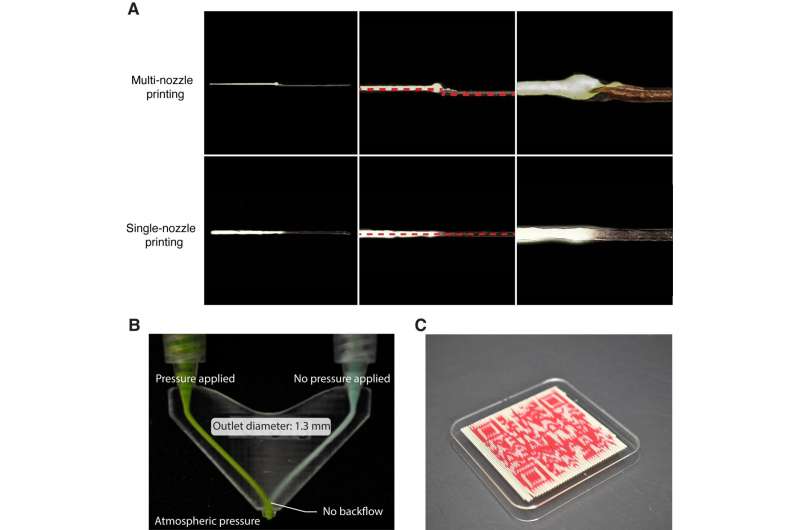This article has been reviewed according to Science X's editorial process and policies. Editors have highlighted the following attributes while ensuring the content's credibility:
fact-checked
trusted source
proofread
Team prints edible QR codes using innovative 3D food printer

Like a scene from the movies, a team of researchers from Singapore University of Technology and Design (SUTD) has developed new ways to freely produce and customize the food that we eat.
Their findings have been published in the journal Future Foods as "Multi-material direct ink writing 3D food printing using multi-channel nozzle."
Three-dimensional (3D) printing using food ingredients is currently the favored approach to shaping foods with unique structures, textures, and nutritional compositions.
"Printing food in 3D enables the customization of nutrients, the creation of aesthetically pleasing meals, and the modification of food texture to suit individual dietary needs," explains principal investigator Michinao Hashimoto, an associate professor at SUTD looking into combining the use of design and technology in research.
Some repurposed food sources, such as okara (soybean dregs), orange peels, and insect protein, tend to ward off appetites by their appearances and origins. By adjusting the printing parameters, researchers can incorporate edible and nutrient-rich ingredients from these unusual sources, and construct an aesthetically pleasing meal.
For the everyday person, this brings to the table a personalized and sustainable means to get the daily grub. At the same time, individuals with eating disorders or who have difficulty swallowing (dysphagic) can customize their mealtime experience and improve their eating habits.
Researchers have successfully printed foods using chocolate, milk, gelatin, and vegetable inks, but these constructs are largely confined to single ingredients. Existing methods struggle with seamless transitions between materials, leading to fragmented prints and increased complexity in the machine printing process, according to Dr. Lee Cheng Pau, the lead researcher of the current study.
One common approach uses multiple nozzles to hold and eject different food constituents, like having a box of color pencils to work with. Requiring careful machine design and nozzle alignment when printing, this approach has discontinuous interfaces, where different materials overlap, and long printing times.
Associate Prof Hashimoto and the team favor a different approach, taking inspiration from microfluidics. With dual inlets and a single outlet, this approach mitigates the intricacies of switching between multiple nozzles by combining the food pipelines before the printing stage.
Combining different food inks by intersecting junctions is not trivial, however. Backflows into the ingredient inlets tend to happen with fluids of different rheological properties—such as flow and viscosity. For example, squeezing out a dab of toothpaste requires more strength than pouring out water. If the two were to feed into a single outlet, pushing out toothpaste would likely send some paste up into the water inlet.
To overcome this challenge, the researchers had to carefully engineer the design of the food printer. The first step was to widen the exit outlet of the Y-junction in the printer to accommodate food ingredient inks that are high-yield-stress, which require more force to extrude. This change offers a lower resistance for the flow, preventing the ink from going up the wrong channel in the printer.
In addition, it is necessary to account for the delay in the food ink transition. As the location for the switching between inks no longer happens at the printing nozzle, the researchers implemented an offset for the printing algorithm.
With their clever design, the team was able to demonstrate seamless and continuous printing between inks with vastly different rheological properties, with minimal backflow. To demonstrate the prowess of their system, they printed the SUTD institutional logo and a fully functional QR code using different milk inks.
Following up on their innovation, the team hopes to optimize the design and technology further to accommodate more inlets and progress toward commercial scalability.
"Our technology can be used to 3D-print foods consisting of multiple materials without compromising the printed structures and appearance," said Dr. Lee. "It can be applied in creating meals tailored to individual dietary needs, aesthetically pleasing dishes, and interactive food experiences such as edible QR codes."
More information: Cheng Pau Lee et al, Multi-material Direct Ink Writing 3D Food Printing using Multi-channel Nozzle, Future Foods (2024). DOI: 10.1016/j.fufo.2024.100376



















